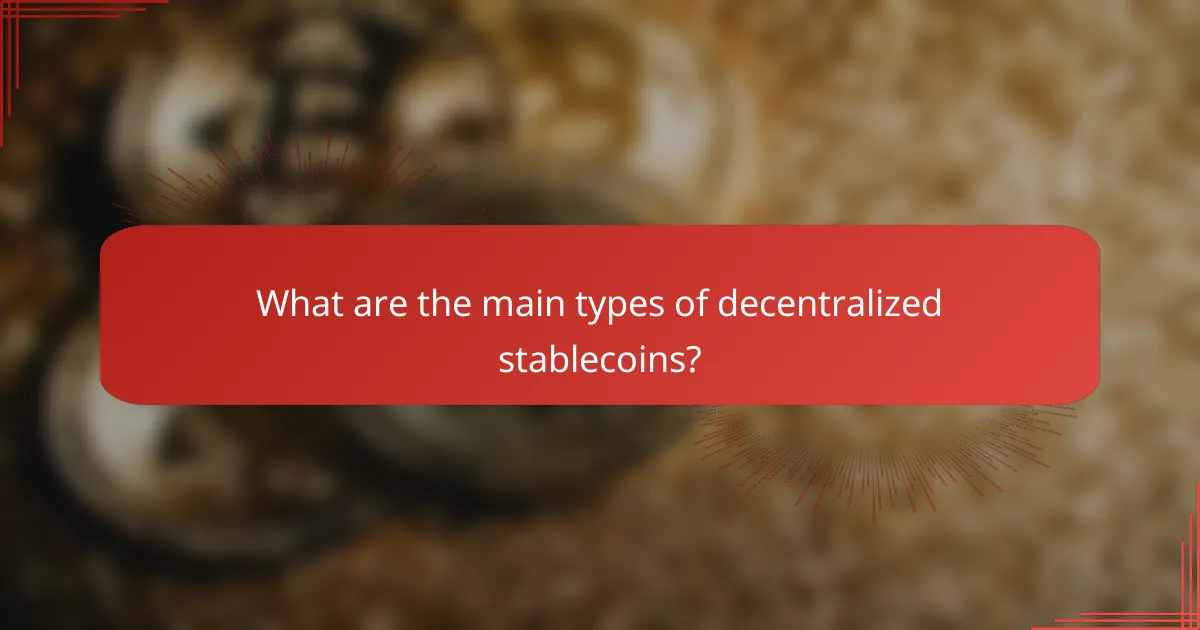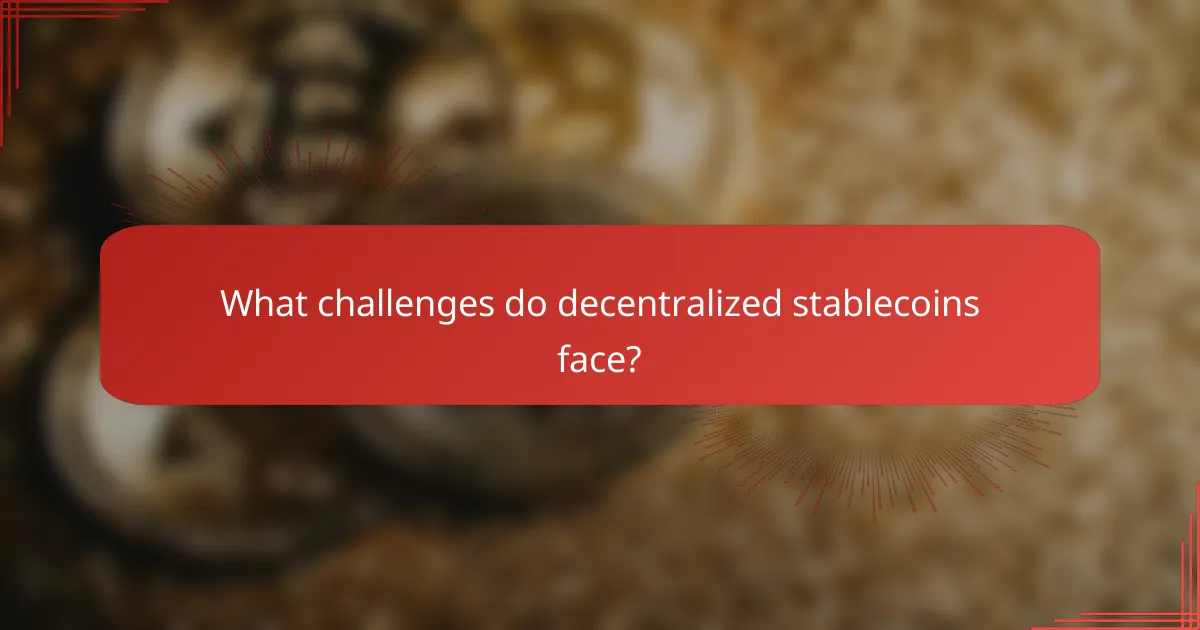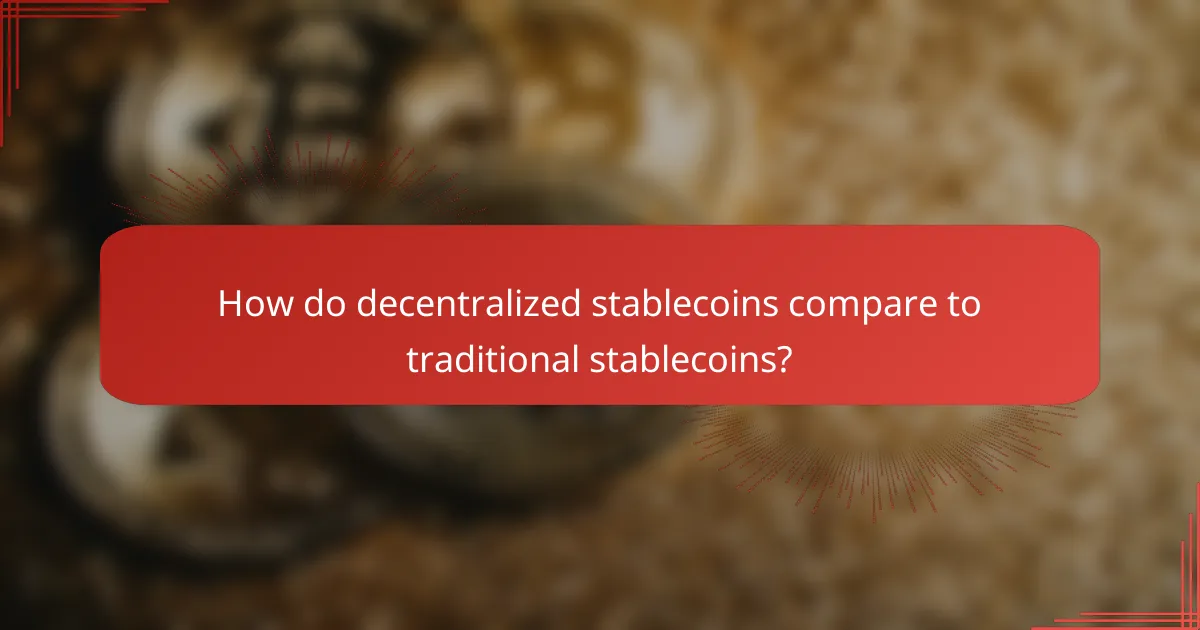Decentralization in stablecoins plays a crucial role in reshaping the financial landscape by providing alternatives to traditional currencies. With various types such as algorithmic, collateral-backed, and hybrid stablecoins, each employs distinct mechanisms to ensure price stability while promoting user autonomy. The advantages of decentralized stablecoins include enhanced financial inclusion, reduced transaction fees, and improved market resilience, all stemming from their independence from central authorities.

How does decentralization impact stablecoins?
Decentralization significantly enhances the functionality and reliability of stablecoins by distributing control across a network rather than centralizing it in a single entity. This structure helps mitigate risks associated with single points of failure and fosters greater user confidence.
Enhanced security and trust
Decentralization improves security by reducing the likelihood of hacking incidents that can occur in centralized systems. When control is distributed, the attack surface is larger, making it more challenging for malicious actors to compromise the entire network. Users often feel more secure knowing that their assets are not held by a single entity.
Trust is further bolstered as decentralized stablecoins operate on transparent blockchain technology, allowing users to verify transactions independently. This transparency fosters a sense of community and shared responsibility among users, enhancing overall trust in the system.
Reduced central authority risks
Decentralized stablecoins minimize the risks associated with central authorities, such as regulatory changes or mismanagement. When no single entity governs the stablecoin, users are less vulnerable to sudden policy shifts that could affect their holdings.
Additionally, decentralization can prevent scenarios where a central authority might manipulate the currency supply or impose unfair fees. This independence from central control is particularly appealing in regions with unstable financial systems or where trust in local institutions is low.
Improved transparency
Decentralization inherently promotes transparency, as all transactions are recorded on a public ledger accessible to anyone. This openness allows users to track the stability and backing of the stablecoin, ensuring that it maintains its peg to the underlying asset, such as the US dollar or euro.
Moreover, decentralized stablecoins often utilize smart contracts to automate processes, which can be audited by anyone. This capability not only enhances accountability but also allows users to verify that the stablecoin is backed by adequate reserves, further solidifying trust in the system.

What are the main types of decentralized stablecoins?
The main types of decentralized stablecoins include algorithmic stablecoins, collateral-backed stablecoins, and hybrid stablecoins. Each type has unique mechanisms for maintaining price stability and varying degrees of decentralization.
Algorithmic stablecoins
Algorithmic stablecoins use smart contracts and algorithms to control supply and demand, aiming to keep their value stable without backing by traditional assets. They adjust the supply of the stablecoin based on market conditions, often through mechanisms like minting or burning coins.
For example, if the price rises above a certain threshold, the system may issue more coins to increase supply and lower the price. However, these coins can be volatile and may fail to maintain their peg during extreme market conditions.
Collateral-backed stablecoins
Collateral-backed stablecoins are pegged to a reserve of assets, which can be cryptocurrencies or fiat currencies. Each stablecoin issued is typically backed by a specific amount of collateral, ensuring that it can be redeemed for its value at any time.
For instance, a stablecoin pegged to the US dollar might require $1 in collateral for every stablecoin issued. This type offers more stability but requires trust in the collateral management and transparency of the reserves.
Hybrid stablecoins
Hybrid stablecoins combine features of both algorithmic and collateral-backed models to enhance stability and reduce risks. They may use collateral to absorb volatility while also employing algorithms to manage supply dynamically.
This approach allows for more flexibility and resilience against market fluctuations. However, the complexity of their mechanisms can introduce additional risks, requiring users to understand both the collateral and algorithmic components involved.

What are the benefits of decentralized stablecoins?
Decentralized stablecoins offer several advantages, including increased financial inclusion, lower transaction fees, and greater market resilience. These benefits stem from their ability to operate independently of central authorities, allowing users to engage in transactions with more freedom and reduced costs.
Increased financial inclusion
Decentralized stablecoins can significantly enhance financial inclusion by providing access to financial services for unbanked populations. Individuals without traditional banking facilities can use stablecoins to store value and transact, often through just a smartphone and internet connection.
For example, in regions with limited banking infrastructure, decentralized stablecoins can facilitate remittances and peer-to-peer transactions, empowering users to participate in the global economy without relying on costly intermediaries.
Lower transaction fees
Transaction fees associated with decentralized stablecoins are typically lower than those of traditional banking systems and centralized cryptocurrencies. This reduction is due to the absence of intermediaries and the efficiency of blockchain technology.
Users can often expect fees in the low single-digit percentages or even fractions of a percent, making decentralized stablecoins an attractive option for frequent transactions, especially in cross-border payments.
Greater market resilience
Decentralized stablecoins tend to exhibit greater market resilience compared to their centralized counterparts. Their distributed nature allows for more robust performance during market fluctuations, as they are less susceptible to single points of failure.
Moreover, decentralized stablecoins can maintain their peg to fiat currencies through various mechanisms, such as algorithmic adjustments or collateralization, which can help stabilize their value even in volatile market conditions.

What challenges do decentralized stablecoins face?
Decentralized stablecoins encounter several significant challenges that can affect their stability and adoption. Key issues include regulatory scrutiny, market volatility, and technical vulnerabilities, each of which can impact their effectiveness and trustworthiness.
Regulatory scrutiny
Decentralized stablecoins often face intense regulatory scrutiny from governments and financial authorities. This is primarily due to concerns about consumer protection, anti-money laundering (AML), and the potential for financial instability. Regulations can vary widely by country, with some jurisdictions imposing strict guidelines while others may have more lenient approaches.
For example, in the European Union, the Markets in Crypto-Assets (MiCA) regulation aims to create a comprehensive framework for crypto assets, including stablecoins. Compliance with such regulations can be costly and complex, potentially stifling innovation in the decentralized finance (DeFi) sector.
Market volatility
Despite their aim to maintain a stable value, decentralized stablecoins can still be affected by market volatility. Factors such as liquidity issues, trading volume fluctuations, and external economic events can lead to price deviations from their pegged value. This volatility can undermine user confidence and hinder adoption.
For instance, during periods of high market stress, the mechanisms that stabilize a decentralized stablecoin may not function as intended, leading to significant price swings. Users should be aware of these risks and consider the underlying mechanisms that support the stablecoin’s value.
Technical vulnerabilities
Decentralized stablecoins are also susceptible to technical vulnerabilities, including smart contract bugs and security exploits. These vulnerabilities can lead to loss of funds or manipulation of the stablecoin’s value. Regular audits and robust testing are essential to mitigate these risks.
Additionally, the reliance on decentralized governance can complicate decision-making and response times in the event of a security breach. Users should prioritize stablecoins with a strong track record of security and transparency to minimize potential risks.

How do decentralized stablecoins compare to traditional stablecoins?
Decentralized stablecoins operate without a central authority, unlike traditional stablecoins that are typically backed by fiat currencies and managed by centralized entities. This fundamental difference affects their governance, risk management, and overall stability.
Control and governance differences
Decentralized stablecoins rely on blockchain technology and smart contracts for governance, allowing users to participate in decision-making processes. This contrasts with traditional stablecoins, where a central organization controls the issuance and redemption of tokens, often leading to concerns about transparency and accountability.
For example, in decentralized stablecoins, holders may vote on protocol upgrades or changes, while traditional stablecoins may have limited user input. This decentralized approach can enhance trust among users but may also lead to slower decision-making processes due to the need for consensus.
Risk management approaches
Risk management in decentralized stablecoins often involves over-collateralization, where users must lock up more assets than the stablecoin’s value to mitigate volatility. In contrast, traditional stablecoins typically maintain a 1:1 peg with fiat currencies, relying on reserves held by the issuing entity.
For instance, a decentralized stablecoin may require collateralization ratios of 150% or more, while traditional stablecoins usually operate with lower reserve ratios. This difference can lead to varying levels of risk exposure, with decentralized options potentially facing higher volatility but offering greater autonomy.


